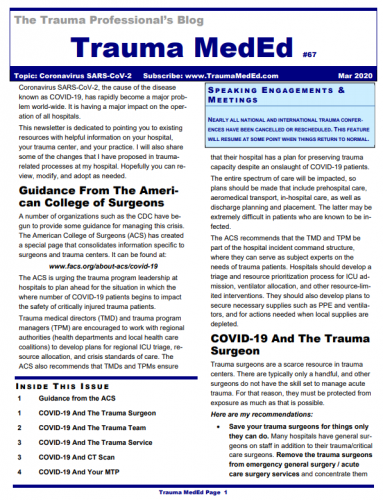Endotracheal intubation is considered an aerosol-producing procedure. In this new age of SARS-CoV-2 and COVID-19, most hospitals are stepping up the level of personal protective equipment (PPE) used when performing this procedure. This has also resulted in modifications in the location where intubation is performed and the choice of drugs used.
But what about needle and chest thoracostomy? These are different than intubation in that the respiratory tract is usually not directly accessed. However, there is the opportunity for exposure to pleural fluid. In the case of needle thoracostomy, it is possible that air under pressure in the chest can force tiny droplets or even an aerosol out and into the air. There is less likelihood of aerosolization during tube thoracostomy, where liquid and droplet exposure can be anticipated.
What do we know about pleural fluid and the novel coronavirus? Basically nothing. And there is very little literature out there regarding other respiratory viruses in pleural fluid either. The only paper I could find (reference below) was published five years ago by a Spanish group. They compared the presence of bacteria and viruses in the pleural fluid of patients with community acquired pneumonia against an uninfected control group. They found only one incidence of virus in the pleural fluid in one patient, a human metapneumovirus. Is this comforting? Probably not.
Trauma patients with chest trauma are likely very different. Those with a hemo- or pneumo-thorax, by definition, had some violation of the surface of the lung. to cause the leak This injury is very likely to breach alveoli which are laden with coronavirus, thus contaminating the pleural fluid. Once that occurs, it is possible that the entire thorax surrounding the lung is contaminated. Note: this is one of those “common sense” assumptions with absolutely no data currently to back it up.
Bottom Line: This is yet another of the many questions about SARS-CoV-2 that we just don’t have an objective answer to. However, since we are already limiting exposure during or forgoing laparoscopic procedures altogether to avoid vaporizing viral particles in smoke, it makes sense to protect ourselves during procedures that involve pleural fluid in trauma patients.
Until we have more data, needle and tube thoracostomy procedures should be considered at least a droplet-prone procedure, if not an aerosol-producing one. This means that trauma professionals should don appropriate personal protective equipment as dictated by their local policies and procedures before performing these procedures.
Reference: Detection of bacteria and viruses in the pleural effusion of children and adults with community-acquired pneumonia. Future Microbiology 10(6):909-916, 2015.

